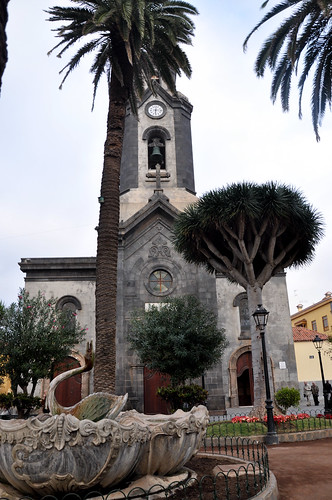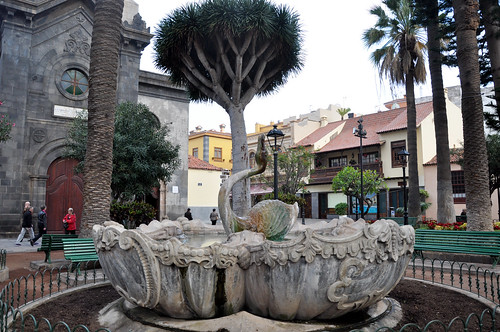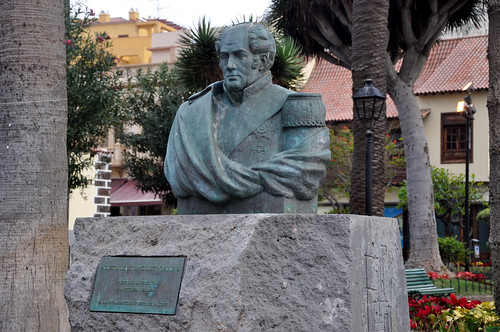Quem a vê de fora não diría que é do século XVII, parece na realidade mais recente e talvez seja a sua torre construída no final do século XIX que nos leve a pensá-lo. Não entrei pela porta principal e mesmo assim fui logo surpreendida pelos três altares que se dividem pelas três naves da igreja. O que tinham de comum era a riqueza do trabalho decorativo para além de varias figuras importantes veneradas pela gente do Puerto de la Cruz.
Who sees it wouldn't problaby say it's from the seventeenth century, in reality in looks more recent and perhaps it is it's tower built in the late nineteenth century that leads us to think so. I did not go through the front door and even I was surprised by the three altars that divide the three naves of the church. What they had in common was the rich decorative work in addition to several important figures venerated by the people of Puerto de la Cruz.
O altar-mor decorado com estilo barroco tem como figura central a Santa que dá o nome á igreja, N.S. de la Peña de Francia. Num outro retablo a figura da Virgen de la Carmen, uma das mais veneradas pelos portuenses, colocada num retablo do século XVIII também ele decorado ao estilo barroco.
A entrada na igreja é gratuita e não tirei muito mais fotografías no seu interior porque entrei na hora da oração. Os seus retablos são sem dúvida a sua maior riqueza.
The main altar is decorated with baroque style, it has as the central figure the Saint that gives the name to the church, NS de la Peña de Francia. In another altarpiece the figure of Virgen de la Carmen, one of the most venerated by the "portuenses" (locals), placed in an eighteenth-century altarpiece also decorated in baroque style.
Admission is free and I did not take much photographs inside because I visited at a hour of prayer. It's altarpieces are undoubtedly its greatest asset.
Admission is free and I did not take much photographs inside because I visited at a hour of prayer. It's altarpieces are undoubtedly its greatest asset.
Em frente á igreja está um pequeno jardim cuja peça central é a sua fonte com uma escultura de um cisne. Junto ás escadas que dão acesso á Calle Quintana está uma escultura de Agustín de Betancourt y Molina, que nasceu nesta parte da ilha de Tenerife e cujos antepassados estão ligados á sua colonização. Foi um brilhante engenheiro que para além de Espanha também viveu na França e na Rússia.
In front of the church there is a small garden whose centerpiece is a fountain with a sculpture of a swan. Standing by the stairs that give access to Calle Quintana is a sculpture of Agustín de Betancourt y Molina, who was born in this part of the island of Tenerife and whose ancestors are linked to its colonization. It was a brilliant engineer who besides Spain also lived in France and Russia.
Mais/More
posts:








Sem comentários:
Enviar um comentário